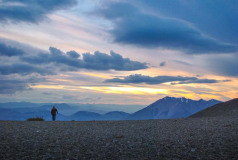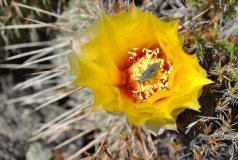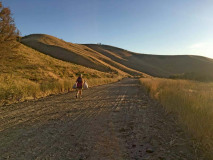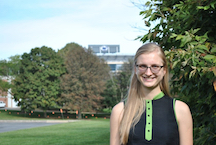No products in the cart.
Ploggers for the Planet
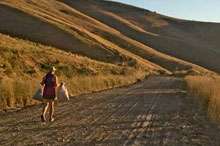
And the Fiftieth Earth Day
By Veronika Vazhnik
On a balmy summer afternoon, the foothills trails are dry and dusty, and I enjoy every step on the gravel and sand, along with the conversation with my fellow runners. It was a long Monday at work, and I had excitedly looked forward to this all-abilities run that would get us into the wilderness. Seven of us women follow the sun and chat away about music, research, and race aspirations. Suddenly, we stumble upon a rusting spring mattress—right in the foothills, in the middle of nowhere.
Then we spot an old plastic bucket. And ten- or twenty-year-old plastic bottles. As we look around, we find lots of metal, plastic, paper—all sorts of trash in the hills, the bushes, and the stream. This is when many runners get grumpy and frustrated with people who visited the wilderness days or years earlier, but our spirits remain high, because we came prepared. We brought plastic bags and gloves to collect the trash we knew we’d see, and we even take pleasure in the cross-training of endless squats to pick up all that plastic and metal.
My point is that people not only leave plastic wraps on Idaho trails, they also clean and restore those trails. Such people might wake at 5 a.m. or meet after work to run in the hills, and when they stumble upon an old fridge or a mattress in the middle of a field or on a mountain trail, they come back to clean up the site. I’m talking about “ploggers,” a term that originated in Sweden to describe people who pick up trash as they jog. Idaho Falls Trail Runners organize events to clean our beautiful trails, and whenever I run with these women and men, I know we’ll leave the place better than we found it. After our Monday run, we left the area carrying fifteen thirteen-gallon bags of trash.
Matthew Ball hikes near Mount Borah at sunset. Veronika Vazhnik photo.
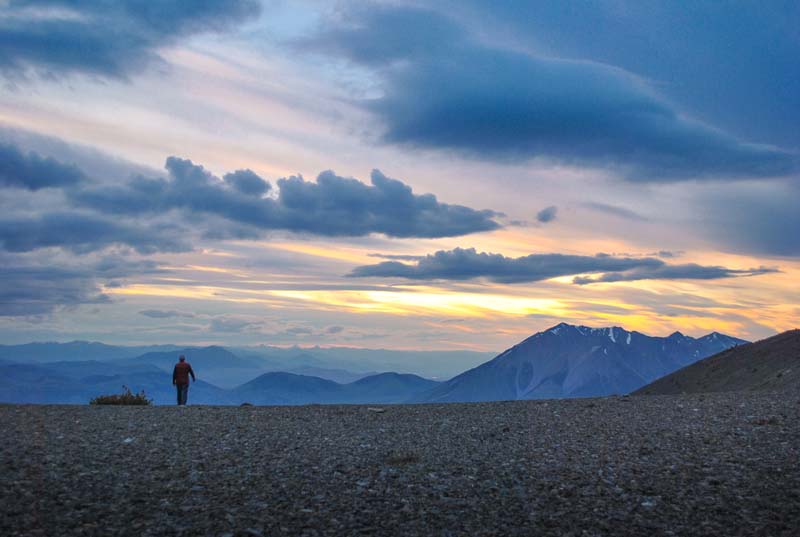
Lava field bloom. Veronika Vazhnik photo.
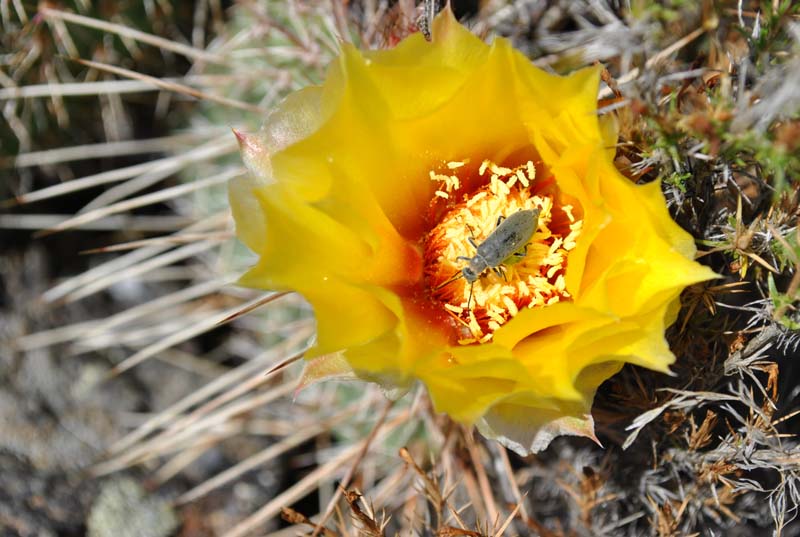
Georgina Goodlander plogs (picks up trash while jogging) near Idaho Falls. Amanda Rynes photo.
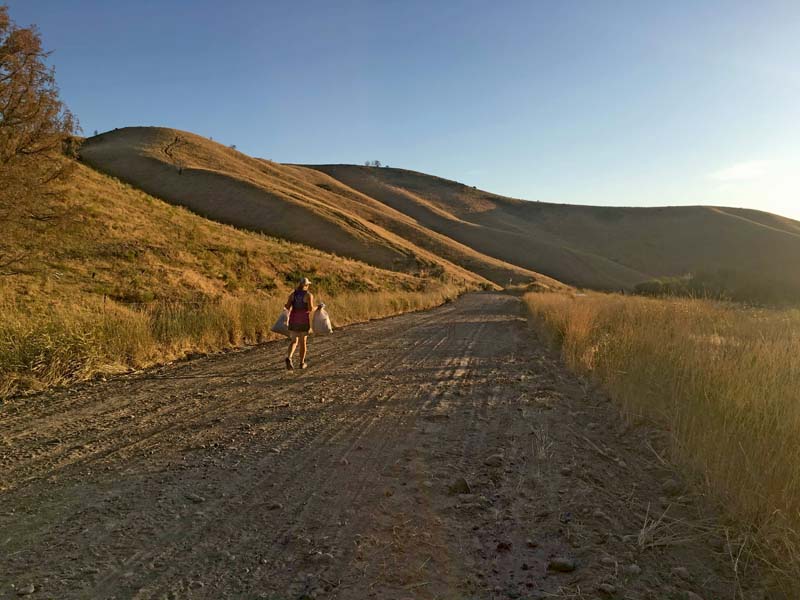
Many times, I’ve asked myself why I love being in Idaho so much. Raised in an eastern European capital with a population of two million, educated in international melting pots like Germany and Hong Kong, what is the likelihood of me loving life in the relatively small town of Idaho Falls? I don’t have to ponder the question for long to find the answer: it must be the nature, it must be the people.
To an environmental scientist like me—or to anyone who is open to see what is around—Idaho generously brings the best of natural wonders. The surprise of seeing radiant flowers in the middle of a black lava desert when Hell’s Half Acre is in bloom, or the peace of looking at the majestic mountains as I fall asleep next to Mount Borah: such natural treasures of Idaho are so different from the other places I’ve lived that I cannot ever take the state’s gifts for granted.
The pristine nature here gives me a sense of home, even though I come from a city. The feeling I get from breathing full breaths, from opening my eyes so wide to capture the sun and the beauty that I have to close them again, because they’re overfilled with light—these experiences are precious and irreplaceable. But because Idaho nature welcomes me like home, I feel equally responsible to care for it as my home.
What is home? To me, it’s a nurturing place that allows me to rest and recharge my batteries. A place that keeps me warm in winter. That brings me tasty food, mmm, and more tasty food! The lava fields, the foothills, the mountains give me space for thought. And those thoughts can be cleared entirely when I get into the freezing waters of a mountain lake (I guess we all find our own mind-clearing techniques, right?). Zero-carbon electricity from sources other than fossil fuels keeps me warm. The wonderful community-supported agriculture (CSA) from farmers in Shelley and other Idaho producers brings the most delicious meals to my table. But even as Idaho soothes, feeds, and warms me (or freezes me when I really ask for it), I wonder, how could I leave its fate to chance or to a possible future of pollution and climate change-caused degradation?
Well, I don’t—or I try not to, and in that I’m not alone. This is why I get so excited about the plogging runs and about so many other encounters in Idaho: I meet the most incredible environmental stewards, especially women, who work tirelessly to preserve the state’s nature and future. To me, Idaho leadership is embodied in Aimée Christiansen—one of Idaho Business Review’s 2019 Women of the Year—an advocate and consultant who strives for a resilient future for Idaho and the world. Another leader is the energetic educator Katelyn Morales, who is raising awareness about climate change and the impact of plastic pollution on local communities. There are hundreds, even thousands, more who deserve to be celebrated and applauded for their efforts, and who inspire me in a truly Idaho way: the conservation way.
As I come home from work and see the shadows from the ruby sunset on the foothills, I have to smile every time. “Thank you, home Idaho, for such glory,” I think. “For the views, the clean water and air, the animals and plants, and the people who keep you as you are.” I also know that six other women and I have helped to keep those foothills clean, so more people can experience the unblemished beauty of the wilderness.
But in addition to feeling the gratitude, I like to celebrate Idaho’s nature and her people, and I think there’s no better time to do that each year than on Earth Day. I was involved in Earth Day even when I lived in Europe and Asia, but in Idaho I feel especially empowered as a volunteer. Here it’s so much easier to find support, because our communities are incredibly close-knit—you just call or visit, and people are excited to help. In Idaho Falls, I volunteer with the Earth Day Committee that brings together other organizations and people from across the region, which makes me feel even more at home, because it helps me to form my Idaho Earth family.
This year is the fiftieth anniversary of Earth Day. I’ll be celebrating my big home, the planet, especially when I think of all the migratory birds that get to visit other beautiful places before returning to Idaho, and all the bananas and avocados (among my favorite foods) that I get to enjoy without leaving the state. Of course, I’ll also be celebrating my somewhat smaller yet still vast new home of Idaho with my newly found conservation family. I hope you celebrate home with me.
Earth Day Celebrations around the State
Following are Idaho celebrations of Earth Day’s fiftieth anniversary:
Idaho Falls will hold a week-long “Earth Week” celebration from April 20-25, culminating on Saturday at Tautphaus Park. Conservation-themed activities will take place throughout the park and at the Idaho Falls Zoo from 10 AM to 3 PM Visit: ifearthday.com
Boise will hold an Earth Day “virtual run,” in which participants choose their course, distance, date, and complete the run any time in April, preferably before the 22nd.
In the Wood River Valley, Hailey Climate Action Coalition will sponsor Earth Week April 18-25. Visit the coalition on Facebook.
City of Rocks National Reserve will hold an Earth Day Celebration on April 18. It will include information about the Monarch butterfly life cycle and conservation efforts, and take-home seeds to start butterfly gardens.Visit: parksandrecreation.idaho.gov/earth-day-celebration-city-rocks
Coeur d’Alene will have a free Earth Day celebration from noon to four on April 25 at the Coeur d’Alene Library. Sponsored by Kootenai Environmental Alliance, its theme is climate change. Visit: kealliance.org/event/earth-day-2020
This content is available for purchase. Please select from available options.
Register & Purchase Purchase Only
Register & Purchase Purchase Only

